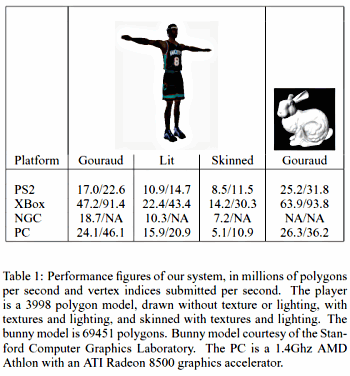I'm sorry I've "pushed" (spammed?) this subject in other forums like nvnews.net but I want your opinion as well.
Is the polygon performance of the PC platform in a bad shape, i.e too low in comparison to the consoles?
Before you answer please take a look at this:
http://217.8.136.112/root/pix/Doom3/fatty.jpg (edgy heads)
http://217.8.136.112/root/pix/Doom3/Doom3_05-01.jpg (fingers and head)
http://217.8.136.112/root/pix/Doom3/handy_smurf.jpg (fingers and tighs)
http://217.8.136.112/root/pix/Doom3/shot0233.jpg (pipes in the ceiling)
Here's a quick blurb I've written:
http://217.8.136.112/pc_low_poly.html
Am I onto something? Should we mention Quake3 is only pushing the CPU (it scales very well) and fill-rate of the 3D-Card when presenting benchmarks from it?
Is the polygon performance of the PC platform in a bad shape, i.e too low in comparison to the consoles?
Before you answer please take a look at this:
http://217.8.136.112/root/pix/Doom3/fatty.jpg (edgy heads)
http://217.8.136.112/root/pix/Doom3/Doom3_05-01.jpg (fingers and head)
http://217.8.136.112/root/pix/Doom3/handy_smurf.jpg (fingers and tighs)
http://217.8.136.112/root/pix/Doom3/shot0233.jpg (pipes in the ceiling)
Here's a quick blurb I've written:
http://217.8.136.112/pc_low_poly.html
Am I onto something? Should we mention Quake3 is only pushing the CPU (it scales very well) and fill-rate of the 3D-Card when presenting benchmarks from it?


